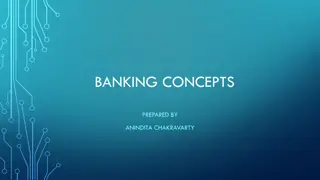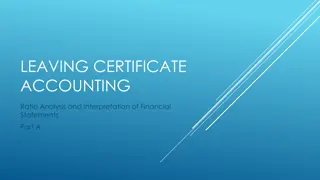Overview of COREAM Ratio Formationis for Formators Course
This presentation provides insights into the COREAM Ratio Formationis, focusing on its evolution, key areas of attention for formators, and the status of its implementation until 2025. It emphasizes the importance of familiarizing with this guide for continual formation in the context of Africa and Madagascar, acknowledging the collaborative efforts behind its development.
Download Presentation

Please find below an Image/Link to download the presentation.
The content on the website is provided AS IS for your information and personal use only. It may not be sold, licensed, or shared on other websites without obtaining consent from the author.If you encounter any issues during the download, it is possible that the publisher has removed the file from their server.
You are allowed to download the files provided on this website for personal or commercial use, subject to the condition that they are used lawfully. All files are the property of their respective owners.
The content on the website is provided AS IS for your information and personal use only. It may not be sold, licensed, or shared on other websites without obtaining consent from the author.
E N D
Presentation Transcript
COREAM, Ratio Formationis COREAM s Formators Course, July 2022
PRELUDE This presentation seeks to: Give an overview of the COREAM, Ratio Formationis (07 April, 2022). Give some attention to the adaptations of the Revised Ratio Formationis Generalis, 2020 made in the COREAM, Ratio. Ignite in the formators here present a passion to read and familiarize themselves with the contents of the COREAM, Ratio. Point some key areas both superiors of Units and formators need to pay attention to when they are part of a common house of formation. 1. 2. 3. 4.
Introduction The current COREAM, Ratio Formationis is a fruit of 8 years of hard work and commitment from the confr res within the conference, the General Secretariat for Initial Formation and the General Council. The work started in 2014. This current version is the product of a 5thattempt of discernment and consultation. I would like to take this opportunity to thank everyone who has been involved in the production of the COREAM, Ratio. It s not in my place to mention names, but it goes without saying that we are thankful to Fr. General and his council, a particular mention goes to Fr. Alberto, the Vicar General who chairs the Secretariat for Initial Formation, and to Fr. Manny, the executive Secretary to the Secretariat for Initial Formation and to his team. We are all but grateful to our COREAM Coordinators from Fr. Guy to the late Fr. Zephirin and our current Coordinator Fr. Noel.
Status of the COREAM, Ratio At the moment the COREAM, Ratio Formationis is AD EXPERIMENTUM till 2025. This does not mean that it is not binding nor does it mean that we should ignore it. This is the time to read it, work with it, apply it, observing and noting its strengths and limitations so that come 2025 if need be, there will be a better Ratio Formationis for COREAM informed by our realities and lived experiences in Africa and Madagascar.
What is a Ratio It is a guide that brings together so many parts: The stages of formation into a progressive, coherent and holistic continual unit. 1. The units of COREAM that their formation structure, directories and programmes stem from one homogenous unit. 2. It provides a set of principles and values to help in the process of continual formation. 3.
Structure of the COREAM, Ratio COREAM, Ratio has 4 parts, namely: FORMATION FOR MISSION 1. FORMATION AGENTS 2. THE STAGES OF FORMATION AND THEIR FIVE (5) DIMENSIONS 3. FORMATION AND APPOINTMENT OF FORMATORS 4.
FORMATION FOR MISSION This part of the COREAM, Ratio highlights the following: The socio-political, religious and economic situation of Africa and Madagascar. It is in such a context and place that we are called and are sent on a mission. Thus, our Missionary and Apostolic priorities are informed by the situation around us. 1. The counter-cultural challenges brought in by fidelity to the Evangelical Counsels (CRF, 12-14). 2. The New Profile of a Redemptorist informed by the Missionary and Apostolic Priorities of the Congregation as a whole and those of COREAM in particular (CRF, 15-22). I would like to encourage you to use this first part even for your recollection days as communities or when you do your Community Life Plan evaluations. 3.
Agents of Formation Here we find almost if not all of the players involved in formation houses. This part of the CRF is helpful to formators in assisting them with the things that they need to be in place an also the people that they need to consider having in order to have a holistic approach to formation. The section also highlights the qualities sought for in a formator. I would like to invite you to spend some time at this section and on your own draw the Profile of a formator.
THE STAGES OF FORMATION AND THEIR FIVE (5) DIMENSIONS The ratio offers a number of practical things that we need to consider from the reception of the formandi up until their transition into ministry. We are encouraged to be thorough in our process of admitting aspirants into our houses of formation. It is highly recommended that the Vocations Promotion Team visit aspiring candidates at their homes and interact with their parents and or guardians.
contd Vocation Promotion and Accompaniment, (including the vocation of mature persons ), 1. Formation Prior to Novitiate (Candidate), 2. Novitiate (Novices), 3. The period from Temporary Profession to Perpetual Profession (temporarily professed / the Formation for Brothers) 4. Pastoral Experience Stage during temporary vows (temporarily professed) 5. Preparation for Perpetual Profession (temporarily professed) 6. Transition to Ministry, (perpetually professed) and 7. Continuing Formation (perpetually professed). 8.
The Five Dimensions Human Dimension 1. Spiritual Dimension 2. Community Dimension 3. Missionary Dimension 4. Academic dimension 5.
Formation and Appointment of Formators This last section focuses on the formation of formators. The CRF emphasizes the importance of formators and their ability and preparedness to undertake their ministry. The CRF discourages the appointment of formators to other key pastoral responsibilities. Formation itself is seen as a ministry that deserves maximum attention. The CRF calls for adequate structures for formation particularly leadership structures, such as, the establishments of boards and the signing of of contracts where two or more units are involved.























